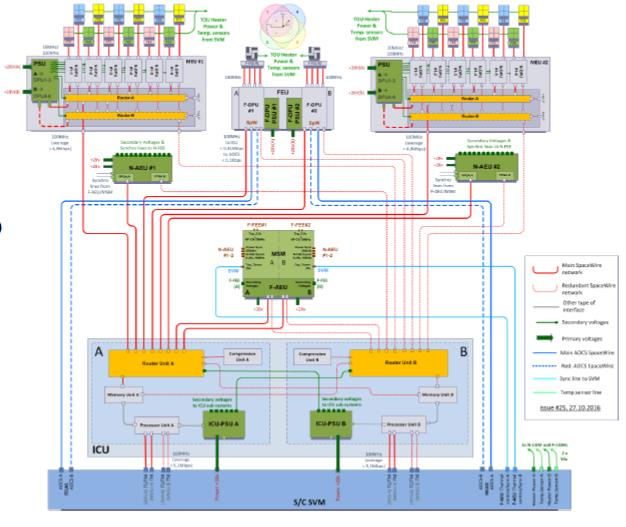The PLATO instrument includes 26 telescopes of 12cm each one, all them togheter collect photons like a telescope of 1 m class covering a field of view 10,000 times the area of the full Moon, it will survey the brightest stars in the sky for transiting planets.
The adquired data is wide enougth to saturate the Earth-to-Satellite comunication bandwidth, so the instrument shall process on orbit the images adquired by the telescopes to obtain the useful data. From the adquired images, the centroid of the targets of interest and their light curves are calculated discarding the remainder data. The data processing task demands as much computer power that a multicomputer system has been developed and included in the instrument.
The multicomputer is structured in 2 boxes, the MEUs (Main Electronic Unit). Each one includes 6 normal data processing unit (N-DPU), which are build around a System-on-Chip that groups in a single IC 2 processors and 6 SpaceWire compliant comunication interfaces.

IAA is also responsible of providing the consortium with the N_DPU (Data Processing Unit) simulator for the FEE operation and the N_DPU EGSE (Electrical Ground Support Equipment) or the instrument integration and verification. The overall MEU activities will be coordinated by Dr. Juan Carlos Suárez (Universidad de Granada), including the participation together with the industry in the MEU project office.
With a staff of highly qualified engineers, specialized in Optics, Mechanics, Electronics, and Software, the UDIT carries out technology developments for either ground-based telescopes or rocket-, balloon-, and space-borne astrophysical payload instrumentation. These developments require the analysis, design, prototyping, manufacturing, and integration of the instruments. Hence, the UDIT has a Mechanical workshop, and Optics, Electronics, and Software Laboratories, as well as two ISO Class 8 clean rooms to perform all these tasks.
The main lines of action in the development of scientific technology are:
- Analysis, design, integration and verification of astronomical instruments for rockets, stratospheric balloons, and scientific spacecrafts.
- Analysis, design, integration and verification of astronomical instruments for ground-based telescopes, for example for the telescopes of Calar Alto Observatory or the Sierra Nevada Observatory.
